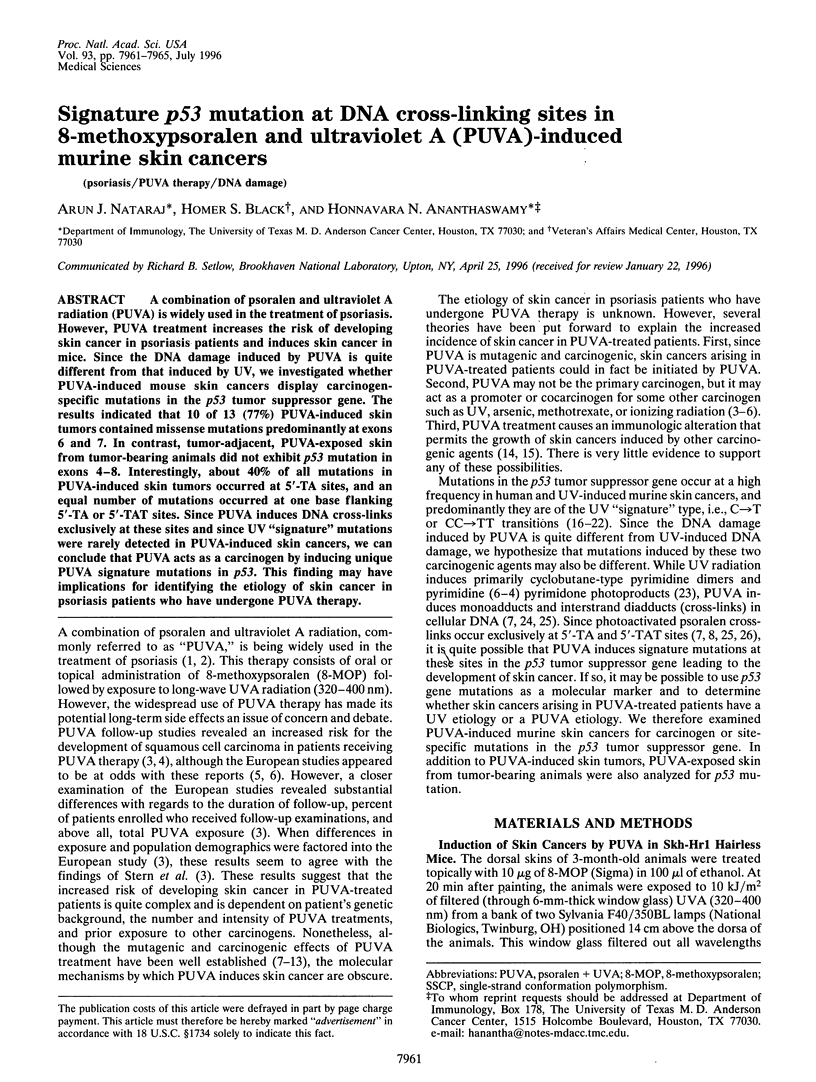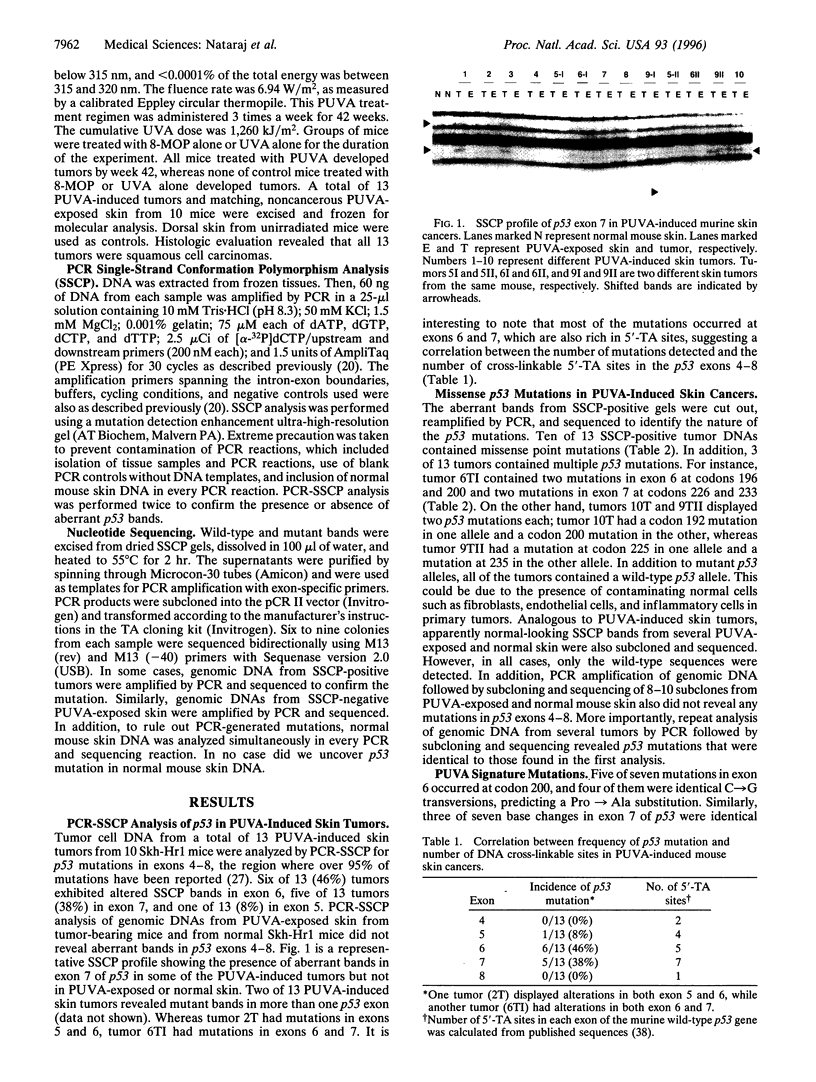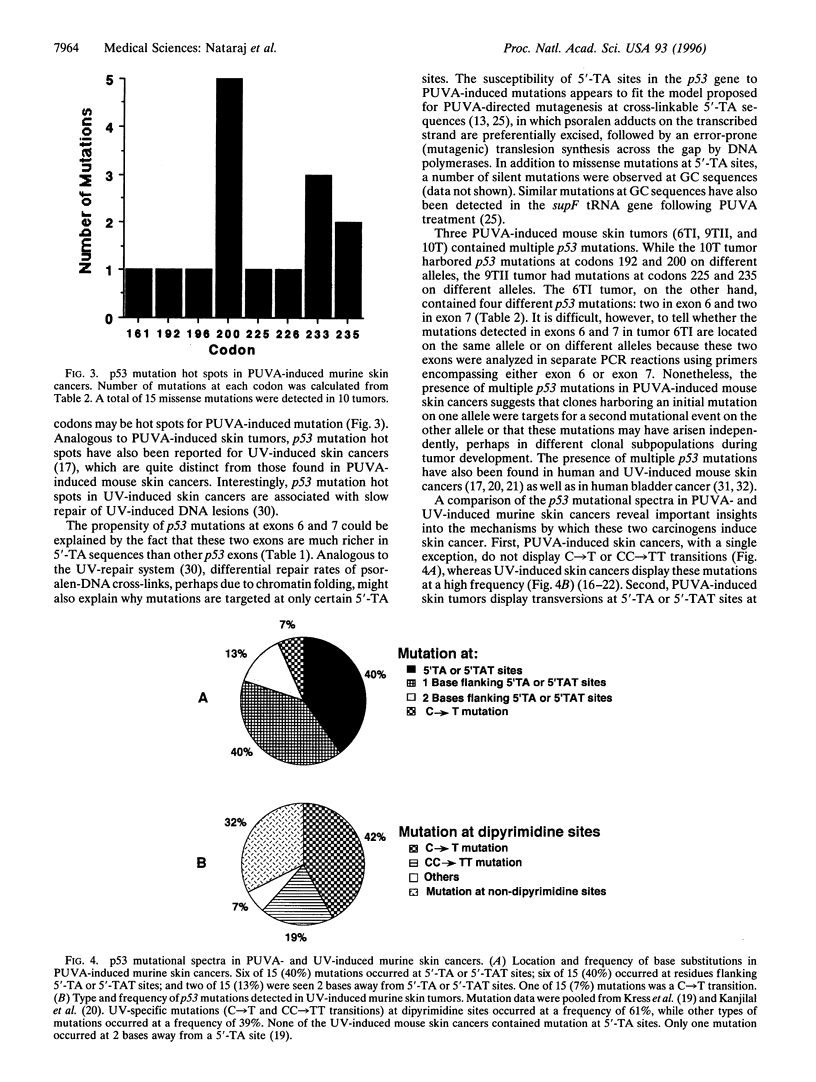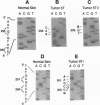Abstract
A combination of psoralen and ultraviolet A radiation (PUVA) is widely used in the treatment of psoriasis. However, PUVA treatment increases the risk of developing skin cancer in psoriasis patients and induces skin cancer in mice. Since the DNA damage induced by PUVA is quite different from that induced by UV, we investigated whether PUVA-induced mouse skin cancers display carcinogen-specific mutations in the p53 tumor suppressor gene. The results indicated that 10 of 13 (77%) PUVA-induced skin tumors contained missense mutations predominantly at exons 6 and 7. In contrast, tumor-adjacent, PUVA-exposed skin from tumor-bearing animals did not exhibit p53 mutation in exons 4-8. Interestingly, about 40% of all mutations in PUVA-induced skin tumors occurred at 5'-TA sites, and an equal number of mutations occurred at one base flanking 5'TA or 5'-TAT sites. Since PUVA induces DNA cross-links exclusively at these sites and since UV "signature" mutations were rarely detected in PUVA-induced skin cancers, we can conclude that PUVA acts as a carcinogen by inducing unique PUVA signature mutations in p53. This finding may have implications for identifying the etiology of skin cancer in psoriasis patients who have undergone PUVA therapy.
Full text
PDF




Images in this article
Selected References
These references are in PubMed. This may not be the complete list of references from this article.
- Ananthaswamy H. N. Neoplastic transformation of C3H mouse embryo 10T1/2 cells by 8-methoxypsoralen plus UVA radiation. J Invest Dermatol. 1985 Aug;85(2):102–106. doi: 10.1111/1523-1747.ep12276467. [DOI] [PubMed] [Google Scholar]
- Bienz B., Zakut-Houri R., Givol D., Oren M. Analysis of the gene coding for the murine cellular tumour antigen p53. EMBO J. 1984 Sep;3(9):2179–2183. doi: 10.1002/j.1460-2075.1984.tb02110.x. [DOI] [PMC free article] [PubMed] [Google Scholar]
- Bohr V. A., Okumoto D. S., Hanawalt P. C. Survival of UV-irradiated mammalian cells correlates with efficient DNA repair in an essential gene. Proc Natl Acad Sci U S A. 1986 Jun;83(11):3830–3833. doi: 10.1073/pnas.83.11.3830. [DOI] [PMC free article] [PubMed] [Google Scholar]
- Bohr V. A., Smith C. A., Okumoto D. S., Hanawalt P. C. DNA repair in an active gene: removal of pyrimidine dimers from the DHFR gene of CHO cells is much more efficient than in the genome overall. Cell. 1985 Feb;40(2):359–369. doi: 10.1016/0092-8674(85)90150-3. [DOI] [PubMed] [Google Scholar]
- Brash D. E., Rudolph J. A., Simon J. A., Lin A., McKenna G. J., Baden H. P., Halperin A. J., Pontén J. A role for sunlight in skin cancer: UV-induced p53 mutations in squamous cell carcinoma. Proc Natl Acad Sci U S A. 1991 Nov 15;88(22):10124–10128. doi: 10.1073/pnas.88.22.10124. [DOI] [PMC free article] [PubMed] [Google Scholar]
- Evans M. K., Taffe B. G., Harris C. C., Bohr V. A. DNA strand bias in the repair of the p53 gene in normal human and xeroderma pigmentosum group C fibroblasts. Cancer Res. 1993 Nov 15;53(22):5377–5381. [PubMed] [Google Scholar]
- Greenblatt M. S., Bennett W. P., Hollstein M., Harris C. C. Mutations in the p53 tumor suppressor gene: clues to cancer etiology and molecular pathogenesis. Cancer Res. 1994 Sep 15;54(18):4855–4878. [PubMed] [Google Scholar]
- Grube D. D., Ley R. D., Fry R. J. Photosensitizing effects of 8-methoxypsoralen on the skin of hairless mice--II. Strain and spectral differences for tumorigenesis. Photochem Photobiol. 1977 Mar;25(3):269–276. doi: 10.1111/j.1751-1097.1977.tb06910.x. [DOI] [PubMed] [Google Scholar]
- Gunther E. J., Yeasky T. M., Gasparro F. P., Glazer P. M. Mutagenesis by 8-methoxypsoralen and 5-methylangelicin photoadducts in mouse fibroblasts: mutations at cross-linkable sites induced by offoadducts as well as cross-links. Cancer Res. 1995 Mar 15;55(6):1283–1288. [PubMed] [Google Scholar]
- Harber L. C. Editorial: Photochemotherapy of psoriasis. N Engl J Med. 1974 Dec 5;291(23):1251–1252. doi: 10.1056/NEJM197412052912312. [DOI] [PubMed] [Google Scholar]
- Henseler T., Christophers E., Hönigsmann H., Wolff K. Skin tumors in the European PUVA Study. Eight-year follow-up of 1,643 patients treated with PUVA for psoriasis. J Am Acad Dermatol. 1987 Jan;16(1 Pt 1):108–116. [PubMed] [Google Scholar]
- Kanjilal S., Pierceall W. E., Cummings K. K., Kripke M. L., Ananthaswamy H. N. High frequency of p53 mutations in ultraviolet radiation-induced murine skin tumors: evidence for strand bias and tumor heterogeneity. Cancer Res. 1993 Jul 1;53(13):2961–2964. [PubMed] [Google Scholar]
- Kress S., Sutter C., Strickland P. T., Mukhtar H., Schweizer J., Schwarz M. Carcinogen-specific mutational pattern in the p53 gene in ultraviolet B radiation-induced squamous cell carcinomas of mouse skin. Cancer Res. 1992 Nov 15;52(22):6400–6403. [PubMed] [Google Scholar]
- Kripke M. L., Morison W. L., Parrish J. A. Induction and transplantation of murine skin cancers induced by methoxsalen plus ultraviolet (320-400 nm) radiation. J Natl Cancer Inst. 1982 Apr;68(4):685–690. [PubMed] [Google Scholar]
- Kripke M. L., Morison W. L., Parrish J. A. Systemic suppression of contact hypersensitivity in mice by psoralen plus UVA radiation (PUVA). J Invest Dermatol. 1983 Aug;81(2):87–92. doi: 10.1111/1523-1747.ep12542071. [DOI] [PubMed] [Google Scholar]
- Mellon I., Bohr V. A., Smith C. A., Hanawalt P. C. Preferential DNA repair of an active gene in human cells. Proc Natl Acad Sci U S A. 1986 Dec;83(23):8878–8882. doi: 10.1073/pnas.83.23.8878. [DOI] [PMC free article] [PubMed] [Google Scholar]
- Morison W. L., Kripke M. L. Systemic suppression of contact hypersensitivity by ultraviolet b radiation or methoxsalen/ultraviolet a radiation in the guinea pig. Cell Immunol. 1984 Apr 15;85(1):270–277. doi: 10.1016/0008-8749(84)90298-3. [DOI] [PubMed] [Google Scholar]
- Nataraj A. J., Trent J. C., 2nd, Ananthaswamy H. N. p53 gene mutations and photocarcinogenesis. Photochem Photobiol. 1995 Aug;62(2):218–230. doi: 10.1111/j.1751-1097.1995.tb05262.x. [DOI] [PubMed] [Google Scholar]
- PATHAK M. A., DANIELS F., HOPKINS C. E., FITZPATRICK T. B. Ultra-violet carcinogenesis in albino and pigmented mice receiving furocoumarins: psoralen and 8-methoxypsoralen. Nature. 1959 Mar 14;183(4663):728–730. doi: 10.1038/183728a0. [DOI] [PubMed] [Google Scholar]
- Parrish J. A., Fitzpatrick T. B., Tanenbaum L., Pathak M. A. Photochemotherapy of psoriasis with oral methoxsalen and longwave ultraviolet light. N Engl J Med. 1974 Dec 5;291(23):1207–1211. doi: 10.1056/NEJM197412052912301. [DOI] [PubMed] [Google Scholar]
- Rabkin S. D., Moore P. D., Strauss B. S. In vitro bypass of UV-induced lesions by Escherichia coli DNA polymerase I: specificity of nucleotide incorporation. Proc Natl Acad Sci U S A. 1983 Mar;80(6):1541–1545. doi: 10.1073/pnas.80.6.1541. [DOI] [PMC free article] [PubMed] [Google Scholar]
- Rady P., Scinicariello F., Wagner R. F., Jr, Tyring S. K. p53 mutations in basal cell carcinomas. Cancer Res. 1992 Jul 1;52(13):3804–3806. [PubMed] [Google Scholar]
- Rosenstein B. S., Mitchell D. L. Action spectra for the induction of pyrimidine(6-4)pyrimidone photoproducts and cyclobutane pyrimidine dimers in normal human skin fibroblasts. Photochem Photobiol. 1987 Jun;45(6):775–780. doi: 10.1111/j.1751-1097.1987.tb07881.x. [DOI] [PubMed] [Google Scholar]
- Sage E., Bredberg A. Damage distribution and mutation spectrum: the case of 8-methoxypsoralen plus UVA in mammalian cells. Mutat Res. 1991 Aug;263(4):217–222. doi: 10.1016/0165-7992(91)90004-n. [DOI] [PubMed] [Google Scholar]
- Sage E. Distribution and repair of photolesions in DNA: genetic consequences and the role of sequence context. Photochem Photobiol. 1993 Jan;57(1):163–174. doi: 10.1111/j.1751-1097.1993.tb02273.x. [DOI] [PubMed] [Google Scholar]
- Sage E., Drobetsky E. A., Moustacchi E. 8-Methoxypsoralen induced mutations are highly targeted at crosslinkable sites of photoaddition on the non-transcribed strand of a mammalian chromosomal gene. EMBO J. 1993 Feb;12(2):397–402. doi: 10.1002/j.1460-2075.1993.tb05671.x. [DOI] [PMC free article] [PubMed] [Google Scholar]
- Sage E., Lamolet B., Brulay E., Moustacchi E., Chteauneuf A., Drobetsky E. A. Mutagenic specificity of solar UV light in nucleotide excision repair-deficient rodent cells. Proc Natl Acad Sci U S A. 1996 Jan 9;93(1):176–180. doi: 10.1073/pnas.93.1.176. [DOI] [PMC free article] [PubMed] [Google Scholar]
- Song P. S., Tapley K. J., Jr Photochemistry and photobiology of psoralens. Photochem Photobiol. 1979 Jun;29(6):1177–1197. doi: 10.1111/j.1751-1097.1979.tb07838.x. [DOI] [PubMed] [Google Scholar]
- Spruck C. H., 3rd, Rideout W. M., 3rd, Olumi A. F., Ohneseit P. F., Yang A. S., Tsai Y. C., Nichols P. W., Horn T., Hermann G. G., Steven K. Distinct pattern of p53 mutations in bladder cancer: relationship to tobacco usage. Cancer Res. 1993 Mar 1;53(5):1162–1166. [PubMed] [Google Scholar]
- Stern R. S., Laird N. The carcinogenic risk of treatments for severe psoriasis. Photochemotherapy Follow-up Study. Cancer. 1994 Jun 1;73(11):2759–2764. doi: 10.1002/1097-0142(19940601)73:11<2759::aid-cncr2820731118>3.0.co;2-c. [DOI] [PubMed] [Google Scholar]
- Stern R. S., Lange R. Non-melanoma skin cancer occurring in patients treated with PUVA five to ten years after first treatment. J Invest Dermatol. 1988 Aug;91(2):120–124. doi: 10.1111/1523-1747.ep12464137. [DOI] [PubMed] [Google Scholar]
- Tanew A., Hönigsmann H., Ortel B., Zussner C., Wolff K. Nonmelanoma skin tumors in long-term photochemotherapy treatment of psoriasis. An 8-year follow-up study. J Am Acad Dermatol. 1986 Nov;15(5 Pt 1):960–965. doi: 10.1016/s0190-9622(86)70257-0. [DOI] [PubMed] [Google Scholar]
- Taylor J. A., Li Y., He M., Mason T., Mettlin C., Vogler W. J., Maygarden S., Liu E. p53 mutations in bladder tumors from arylamine-exposed workers. Cancer Res. 1996 Jan 15;56(2):294–298. [PubMed] [Google Scholar]
- Tornaletti S., Pfeifer G. P. Slow repair of pyrimidine dimers at p53 mutation hotspots in skin cancer. Science. 1994 Mar 11;263(5152):1436–1438. doi: 10.1126/science.8128225. [DOI] [PubMed] [Google Scholar]
- Vos J. M., Hanawalt P. C. Processing of psoralen adducts in an active human gene: repair and replication of DNA containing monoadducts and interstrand cross-links. Cell. 1987 Aug 28;50(5):789–799. doi: 10.1016/0092-8674(87)90337-0. [DOI] [PubMed] [Google Scholar]
- Yang S. C., Lin J. G., Chiou C. C., Chen L. Y., Yang J. L. Mutation specificity of 8-methoxypsoralen plus two doses of UVA irradiation in the hprt gene in diploid human fibroblasts. Carcinogenesis. 1994 Feb;15(2):201–207. doi: 10.1093/carcin/15.2.201. [DOI] [PubMed] [Google Scholar]
- Ziegler A., Jonason A. S., Leffell D. J., Simon J. A., Sharma H. W., Kimmelman J., Remington L., Jacks T., Brash D. E. Sunburn and p53 in the onset of skin cancer. Nature. 1994 Dec 22;372(6508):773–776. doi: 10.1038/372773a0. [DOI] [PubMed] [Google Scholar]
- Ziegler A., Leffell D. J., Kunala S., Sharma H. W., Gailani M., Simon J. A., Halperin A. J., Baden H. P., Shapiro P. E., Bale A. E. Mutation hotspots due to sunlight in the p53 gene of nonmelanoma skin cancers. Proc Natl Acad Sci U S A. 1993 May 1;90(9):4216–4220. doi: 10.1073/pnas.90.9.4216. [DOI] [PMC free article] [PubMed] [Google Scholar]





